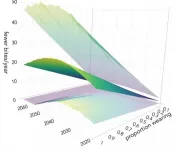(Press-News.org) Early treatment with anti-VEGF injections slowed diabetic retinopathy in a clinical study from the DRCR Retina Network (DRCR.net). However, two years into the four-year study its effect on vision was similar to standard treatment, which usually begins at the onset of late disease. The intermediate findings published today in the JAMA Ophthalmology. The study was supported by the National Eye Institute (NEI), a part of the National Institutes of Health.
"While it is possible that preventive injections of anti-VEGF drugs may help protect vision in the longer-term, we saw no effect on vision at two years," said Raj Maturi, M.D., Indiana University, the protocol chair for the study. "These 2-year results suggest that close monitoring and routine treatment when complications develop are key to preventing vision loss from diabetic retinopathy."
An estimated 30 million Americans have diabetes, which can cause blood vessel abnormalities, including the growth of new blood vessels in the eye, called diabetic retinopathy. In the early stages of diabetic retinopathy, called non-proliferative diabetic retinopathy (NPDR), changes in the eye's blood vessels are visible to clinicians but generally do not affect sight. In the advanced stages, people can develop proliferative diabetic retinopathy (PDR), where retinal blood vessels grow abnormally, and/or diabetic macular edema (DME), where fluid leaks out of the retinal blood vessels. Both can lead to vision loss and blindness. Treatment, such as with anti-VEGF drugs, can slow or prevent vision loss in people with PDR or DME, as long as treatment occurs promptly.
In this study, participants with NPDR were randomly assigned at baseline to receive either injections of Eylea (aflibercept) or a sham injection. They were examined at one, two, and four months, and then every four months for two years, receiving Eylea or sham injection at each visit. The researchers tracked their visual acuity and the severity of their diabetic retinopathy. If disease progressed, regardless of whether they were in the treatment or sham group, participants were given Eylea more frequently as is given in standard practice. If their condition did not improve with additional anti-VEGF treatment, participants could be given treatments such as laser photocoagulation or surgery if necessary.
The study included 328 participants (399 eyes). In two years, the rate of PDR development was 33% in the control group, compared with 14% in the treatment group. Likewise, the rate of development of DME affecting vision was 15% in the control group, compared with 4% in the treatment group. However, loss of visual acuity was essentially the same between the two groups at 2 years, suggesting that standard treatment at the appearance of PDR or DME affecting vision is sufficient to prevent further vision loss at this time point.
"We have a really good treatment for these diseases, so we can manage vision complications that may arise as disease progresses for many eyes," said Adam Glassman, Jaeb Center for Health Research, director of the DRCR.net coordinating center. "When evaluating new preventative treatment strategies, it is important to compare them directly to the standard treatment after disease worsens, as we have done in this study."
"Although we did not see any difference in visual outcomes at two years, the four-year follow-up is going to be very important," said Jennifer Sun, M.D., M.P.H., Joslin Diabetes Center, Harvard Medical School, chair of Diabetes Initiatives for the Network. "We look toward the four-year data to see whether reducing rates of diabetic retinopathy worsening will lead to long-term improvement in visual outcomes."
INFORMATION:
The Clinicaltrials.gov identifier for this study is NCT0634333. The study was supported by NEI and the National Institute of Diabetes and Digestive and Kidney Diseases, with funding through the Special Diabetes Program, through a cooperative agreement (EY14231). Regeneron provided aflibercept for the study and funds to DRCR Retina Network to defray the study's clinical site costs. JDRF also provided funds to defray clinical site costs.
Reference: Maturi RK, Glassman AR, Josic K, Antoszyk AN, Blodi BA, Jampol LM, Marcus DM, Martin DF, Melia M, Salehi-Had H, Stockdale CR, Punjabi OS, and Sun JK, for the DRCR Retina Network. "A Randomized Trial of Intravitreous Anti-VEGF for Prevention of Vision Threatening Complications of Diabetic Retinopathy (Protocol W)." JAMA Ophthalmology. March 30, 2021.
NEI leads the federal government's research on the visual system and eye diseases. NEI supports basic and clinical science programs to develop sight-saving treatments and address special needs of people with vision loss. For more information, visit https://www.nei.nih.gov.
About the National Institutes of Health (NIH): NIH, the nation's medical research agency, includes 27 Institutes and Centers and is a component of the U.S. Department of Health and Human Services. NIH is the primary federal agency conducting and supporting basic, clinical, and translational medical research, and is investigating the causes, treatments, and cures for both common and rare diseases. For more information about NIH and its programs, visit https://www.nih.gov/.
NIH...Turning Discovery Into Health®
A new mathematical model suggests that the easing of lockdown must be accompanied by wider and more effective use of control measures such as facemasks even with vaccination, in order to suppress COVID-19 more quickly and reduce the likelihood of another lockdown.
The model, developed by scientists at the Universities of Cambridge and Liverpool, is published today in the Journal of the Royal Society Interface. It uses mathematical equations to provide general insights about how COVID-19 will spread under different potential control scenarios.
Control measures involving facemasks, handwashing and short-scale (1-2 metre) social distancing can all limit the number of virus particles being spread between people. These are termed ...
With shark bites increasing in countries like Australia - scientists say the use of personal electronic deterrents is an effective way to prevent future deaths and injuries which could save the lives of up to 1063 Australians along the coastline over the next 50 years.
The research, published in scientific journal Royal Society Open Science, shows that while shark bites are rare events, strategies to reduce shark-bite risk are also valuable because they can severely affect victims and their support groups - with one third of victims experiencing post-traumatic stress ...
Heart attacks in young adults are twice as likely to be fatal in those with inflammatory conditions like psoriasis, lupus or rheumatoid arthritis. That's the finding of a study published today in the European Journal of Preventive Cardiology, a journal of the European Society of Cardiology (ESC).1
At least 2% of people in Europe and worldwide have systemic inflammatory diseases, which often affect multiple organ systems. Many of these systemic inflammatory diseases are driven by autoimmunity, meaning the body's immune system attacks itself. Psoriasis is the most common and causes red, itchy, scaly patches on the skin, and can also cause inflammation in the joints. Rheumatoid arthritis leads to inflammation in joints of the hands and feet and in other organ systems. In systemic ...
Red algae that grow in Cornwall's Fal Estuary are genetically unique, new research shows.
University of Exeter scientists studied the population genetics of Phymatolithon calcareum, a coralline red algal species that forms maerl beds in shallow coastal seas from Portugal to Norway.
Large maerl beds fulfil a similar role to tropical coral reefs, providing habitats and vital shelter for hundreds or even thousands of fish and invertebrates. These algae also play an important role in storing carbon.
The findings reveal genetic differences are "structured geographically", with slight variations between populations sampled from across this large geographic area.
However, maerl ...
Human disturbance in urban environments makes some squirrels fail, but others perform better in novel problem-solving.
Unlike natural environments, urban areas have artificial buildings, traffics, less greenery and, most prominently, more humans. Despite these seemingly 'harsh' or stressful characteristics, some wildlife like the Eurasian red squirrel have chosen to settle down in urban environments, and they thrive. Urban wildlife often show higher behavioral flexibility and increased ability to solve novel problems, and thus can exploit new resources. However, which characteristics of urban environments influence animals' performance, and their relative importance, have remained ...
Scientists have discovered a new genetic disease, which causes some children's brains to develop abnormally, resulting in delayed intellectual development and often early onset cataracts.
The majority of patients with the condition, which is so new it doesn't have a name yet, were also microcephalic, a birth defect where a baby's head is smaller than expected when compared to babies of the same sex and age.
Researchers from the universities of Portsmouth and Southampton found that changes in a gene called coat protein complex 1 (COPB1) caused this rare genetic disease.
Now the variant has been identified, it will help clinicians come up with targeted interventions to help patients and their families, also opening the door to screening and prenatal ...
A new study examining how people with severe and profound intellectual disabilities resist activities while in care recommends that institutions improve training to help carers better understand non-verbal cues, as well as offer greater flexibility to allow individual preferences to take priority over institutional schedules.
The research, published in the journal Sociology of Health and Illness, investigated how people with limited language ability expressed their wishes and preferences, and how their support workers responded. It was carried out at a residential home and a day care centre in the UK.
The study, by Dr Clare Nicholson of St Mary's University, Twickenham, and Dr Mick ...
In the run up to hibernation, grizzly bears go on a colossal binge, consuming as many calories as possible to get them through the long winter. Yet, little was known about how much energy the massive mammals use as they shamble around their rugged territories. 'Moving across the landscape in search of food can be a huge energetic expense for some animals', Carnahan says. Fortunately, the Washington State University Bear Research, Education and Conservation Center (WSU BREC), where Carnahan is based, is home to 11 bears, including four that formerly lived in Yellowstone National Park, so he and Charles Robbins (also at WSU BREC) decided to measure the animals' metabolic rates as they sauntered on the flat, and up and down gradients to find out how much ...
New research published in Anaesthesia (a journal of the Association of Anaesthetists) challenges the guidance that special aerosol precautions are only needed when using oxygen therapies for COVID-19 patients, and raises concerns about safety of staff and patients on hospital wards, if they are not protected from infectious aerosols.
The study set out to examine whether oxygen therapies used for patients with severe COVID-19 produce large amounts of small respiratory particles called aerosols, which can transmit virus and can evade routine precautions used on hospital wards. ...
Rock art of human figures created over thousands of years in Australia's Arnhem Land has been put through a transformative machine learning study to analyse style changes over the years.
The study has tested different styles labelled 'Northern Running figures', 'Dynamic figures', 'Post Dynamic figures' and 'Simple figures with Boomerangs' to understand how these styles relate to one another.
Working with the Mimal and Marrku Traditional Owners of the Wilton River area in Australia's Top End, South Australian researchers led by Flinders University archaeologist Dr Daryl Wesley have taken a closer look at the art of this region.
Flinders researcher Jarrad Kowlessar and the team used machine learning ...



